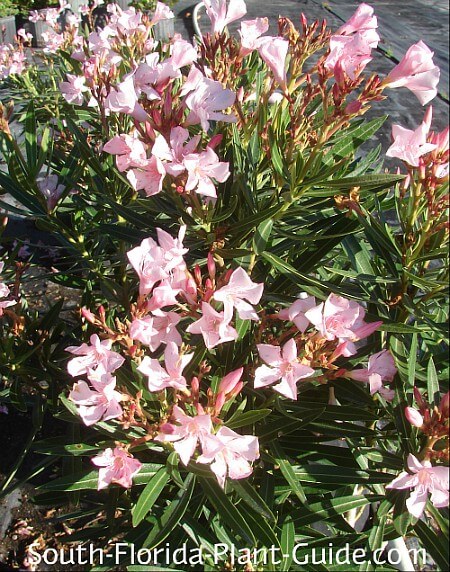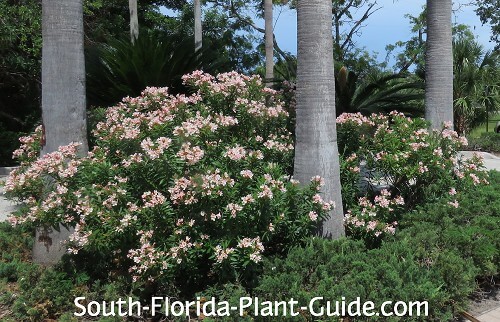Dwarf Oleander
Nerium oleander 'Petite Pink'
A beauty of a plant, dwarf oleander 'Petite Pink' is hardy, compact, and adds a splash of color to the landscape.

This smaller size makes oleanders available to homeowners who don't have the large space it takes to grow full-size varieties.
'Petite Pink' is the most commonly available dwarf variety, with pastel pink blossoms that can blanket the entire shrub.
If you ever wonder if a shrub is easy care, check to see how many
commercial locations are using it. Dwarf oleander is often planted on
the grounds of banks and other businesses. Care is minimal and the rewards are great.
Oleanders are poisonous if ingested, so keep this in mind if you have small children or pets that may munch their way around the garden.
Usually the only issue gardeners face - and not everyone is affected - is a skin irritation from the sap while trimming and handling cuttings.
The solution is to wear garden gloves when pruning the plant, as well as sunglasses (a plant's stem can squirt you in the eye when you cut it).
Certain caterpillars like oleander plants. They devour the leaves and cocoon nearby. The dwarf oleander doesn't seem to be as susceptible to these pests are full-size varieties but there's always that possibility.
To avoid attracting the nerium caterpillar, place your plants away from structures where the bugs can cocoon. Check your shrubs regularly - if you spot caterpillars, begin a regimen of spraying thuracide - a natural bacteria - immediately.

Plant specs
Oleander shrubs are evergreen, cold hardy plants, thriving in both Zone 9 and 10.
They're moderately salt-tolerant plants that prefer full to part sun areas and are moderately drought tolerant once established.
The Petite Pink dwarf variety grows to about 4 feet tall but can easily be kept at 3 feet.
Bloom time is on and off all year, more in warmer months.
Oleanders are considered to be deer-resistant plants.
Plant care
Add top soil to the hole when you plant - or substitute organic peat humus. You can add composted cow manure as well to enrich the soil around the root ball.
Cut back hard in the spring...late March or early April. Trim to shape anytime.
Give your plants a regular drink with time to dry out between waterings.
Fertilize 3 times a year - in spring, summer and autumn - with a quality granular fertilizer. You can supplement feedings to promote more bloom by fertilizing with bone meal and/or liquid.
Plant spacing
Place these dwarf shrubs about 3 feet apart. They're best planted away from the house to avoid possible caterpillar problems, but if you decide to plant against the house come out at least 3 feet.
This small, pink oleander will grow in a container, though it does best planted in the ground.
Landscape uses for dwarf oleander
- around the patio
- as a low to medium hedge
- around tall palms or trees that let plenty of sunlight through
- along the property line
- lining a walk or driveway
- accent for a garden bed
GOOD SNOWBIRD PLANT: NO
COMPANION PLANT SUGGESTIONS: Gold mound, plumbago, star jasmine, ruella, snowbush, Green Island ficus, Panama rose, blueberry flax lily, and juniper.
Other shrubs you might like: Oleander (full-size), Nora Grant Ixora
Take a break!
The ultimate guide to low-maintenance plants
and landscaping!
An ebook by
Chase Landre
author of
South-Florida-Plant-Guide.com
Learn more!
Get a greener thumb!
Want to learn more about South Florida planting, watering, fertilizing and dealing with weeds and pests?
See our Gardening How-To section for answers!
Get instant curb appeal!
An ebook by
Chase Landre
author of
South-Florida-Plant-Guide.com
Learn how to get instant curb appeal with fast growing plants and landscaping techniques!


